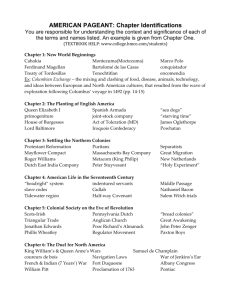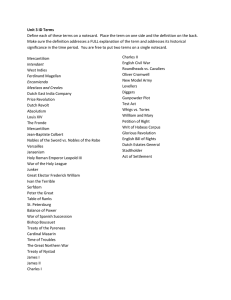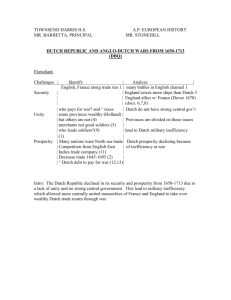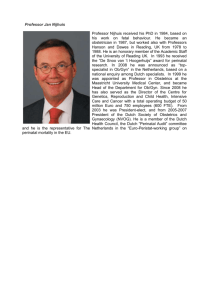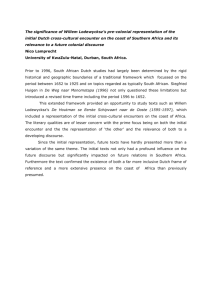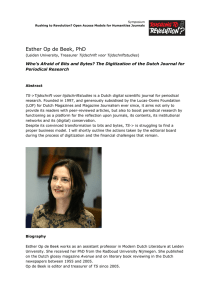Paper Language variation as a nuisance
advertisement
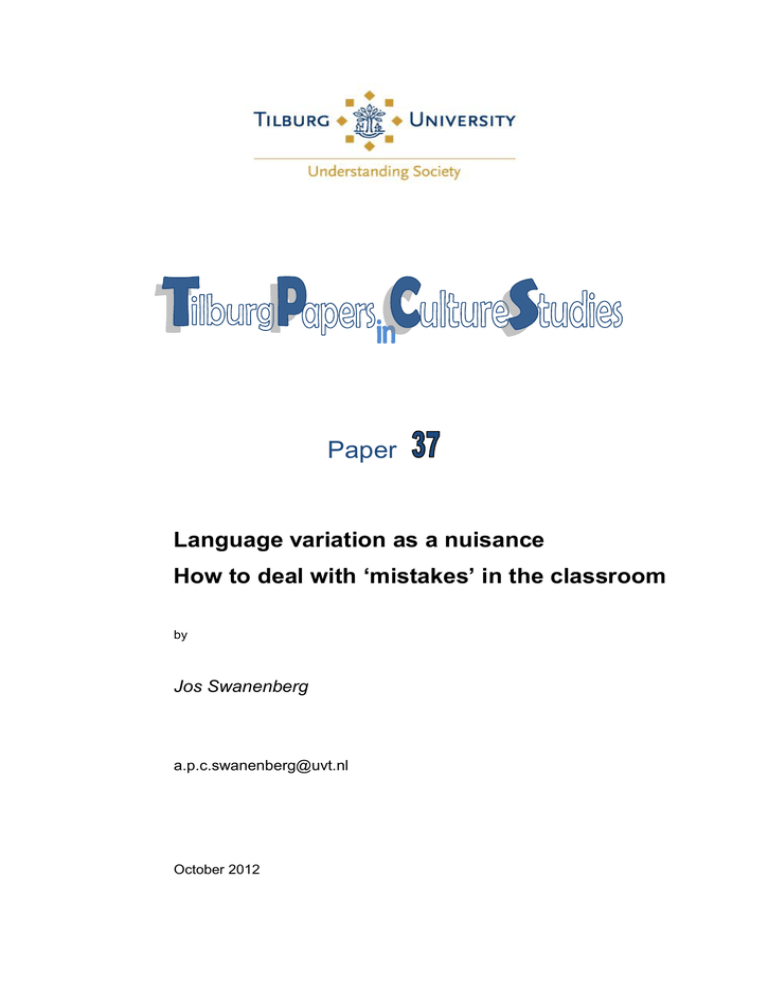
Paper Language variation as a nuisance How to deal with ‘mistakes’ in the classroom by Jos Swanenberg a.p.c.swanenberg@uvt.nl October 2012 Language variation as a nuisance How to deal with ‘mistakes’ in the classroom Jos Swanenberg a.p.c.swanenberg@uvt.nl Language variation as a nuisance How to deal with ‘mistakes’ in the classroom Jos Swanenberg A language of instruction is usually conceived to be a clearly defined language category. In the classroom teachers and students are supposed to know how to learn, teach and use ‘proper’ Dutch. Outside the classroom however, the Dutch language obviously is a continuously changing and quite a diverse entity. In everyday speech and in digital writing we usually do not use ‘proper’ Dutch but we use varieties of an informal and highly diverse language. The most important public domains, which used to be the forums for Standard Dutch, such as national television or national politics, have more and more become playgrounds for language variation. Role models like football players, characters in (reality) soap series, artists etc. often show their most ‘natural’ face in the media; emotion has become a valuable thing in the media and emotion goes hand in hand with informal language. Language professionals often criticize this process1. In addition educational institutions remain bound to the rules of Standard Dutch. It seems that social acceptance of language variation in informal but also in more formal settings has increased strongly, but as a language of instruction Dutch does not follow the ongoing process. This leads to classroom situations where language variation becomes a nuisance if role models on television say ‘hun hebben’ or ‘ze is slimmer als mij’, students will do the same at school. How should teachers deal with grammatical and lexical mistakes that are becoming more and more common practice in national media and other domains? Will education still be one of the pivotal canonical pillars amongst which a national language, culture and identity are built? Will language competence, e.g. in spelling it correctly, still be a criterion for national identity? This paper is based on a research report by an outreaching lab the author of this paper supervised in 20112. The lab-team3 wrote a recommendation report for FLOT (Teacher 1 Former chief editor of Elsevier Nic van Rossum writes ironically: “ik irriteer me daar mateloos aan, zeker als ik me besef dat niemand zich bedenkt welke wartaal hij uitslaat.” (03-15-2008). Here ‘irriteer’ is used as a reflexive verb, which it is not in standard Dutch. 2 The Outreaching program is meant for high-performing Bachelor’s students of various disciplines at Tilburg University, who wish to enrich and deepen their university experience. Students are assigned in teams forming an Outreaching Lab, and deal with a topic in the social sphere under the supervision of an external professor. 3 Yvonne Bolsius, Natan Halim, Lieke Hofmans, Milou van Mulken, Max de Ruijter, Christiaan Teeuwen. Training College for Secondary Education in Tilburg, the Netherlands) on how to cope with the situation sketched above. The lab-team carried out interviews with the Dutch linguists Jan Stroop and Helen de Hoop and attended a seminar by Jan Stroop and another linguist Stefan Grondelaers. Furthermore, they spoke with the Dutch Language Union and discussed the problem with primary school teachers and with PABO (Teacher Training College for Primary Education) and FLOT students. Method Research data were gathered from interviews and an experiment. The lab-team spoke with professors and students at a Dutch Teacher Academy (FLOT), primary school teachers and PABO students, but also with linguists and language policymakers. All interviews were recorded with a voice recorder and transcribed. To gather information about how the practitioners experience the use of non-Standard Dutch in classrooms, the lab-team held a discussion with two professors (‘teachers of teachers’) and two students from FLOT. The discussion focussed on the Dutch (standard) language, language variation and corrective behaviour in class. The answers of teachers and students within the discussion were separated carefully. The lab-team also interviewed the principal and a teacher of a primary school in Tilburg on how they cope with language mistakes. It also spoke with them about their own language practices in class. Furthermore a PABO student was interviewed. We asked her about her internship experiences concerning the use of Dutch and corrective behaviour in a primary school. Furthermore, we gained information about different linguists’ viewpoints. We organised a seminar on the “corruption” of Dutch language at FLOT on September 27th 2011. During this seminar Jan Stroop and Stefan Grondelaers gave a lecture on how Dutch teachers should cope with language variation in classrooms. After the seminar the lab-team interviewed Jan Stroop. Furthermore an interview was held with Helen de Hoop, who featured in a television discussion on the ‘hun’-issue4. Finally an interview with Rik Schutz from the Dutch Language Union was arranged. The Language Union is an international institution for discussing issues regarding the Dutch standard language in the Netherlands, Flanders and Surinam. An additional experiment was conducted among 26 children in the 8th grade of a primary school in Tilburg to test what children consider to be mistakes in Dutch. They were instructed 4 The issue is on the use of the object-form of the pronoun (hun) in subject position: “hun hebben het gedaan”; the subject form is ze, zij. to underline everything they considered to be ‘wrong’ in the text we provided them with. This experiment was based on an earlier experiment by Leonie Vink5, in which she investigated language mistakes and linguistic regionalisms (interference of local dialects) made by students at the PABO. Results Interviews with professors and students at FLOT, Dutch Department Both students and lecturers at Fontys Teacher Training College in Tilburg (FLOT) agree that “both written and spoken language should be expressed in the most correct manner (according to the known standards)”. Although they are aware of the importance of speaking the standard language correctly in every occasion at school, especially when they teach, they have to admit there are some difficulties of enforcing this to every student and lecturer. In the first place it is very difficult for some students to lose the linguistic features of the language in which they have been raised (e.g. dialect interference). Consequently FLOT cannot enforce this very strictly to their students, since it is having difficulties in finding the best method to do so. Secondly some of the professors themselves do not speak ‘proper’ Dutch. This situation is currently not dealt with, mainly because such irregularities are ignored in order to maintain healthy relationships at the workplace, according to the informants. Some of the students, who have done internships in secondary schools, indicated problems they discovered with the students at those schools. They said these are mainly due to the ignorance of the students in speaking ‘proper’ Dutch. For the students speaking in a correct standardized language does not seem very important. They also discovered that problems occurred more often with students who speak another language at home (local dialects or immigrant languages). As an educational institution FLOT is aware of the importance of maintaining the standard Dutch language as one of their most important duties. Nevertheless they are currently facing difficulties in doing so. Since they are practitioners, they are not really concerned with the discussion on language change and the debate on standard language and language variation. They just stick to the standard rules as described in books, which they consider important to be kept and taught, since they are an educational institution educating future Dutch teachers. 5 L. Vink (2011) “Daar verschiet ik van.” Een onderzoek naar wat pabo-studenten verstaan onder Standaardnederlands. Bachelorthesis Radboud University Nijmegen. Students at FLOT have shown to be prone to make the same common mistakes in the Dutch language as the ones we know as ‘language nuisances’: e.g. the use of the object form in subject position, ‘hun hebben het gedaan’. The students think it necessary to correct both the spoken language (where they think the main problem lies) and written language of students at FLOT. They suggest this can be achieved by first of all motivating teachers to use Dutch correctly themselves. It can be expanded by having each student at FLOT (not only the students taking a course to become a Dutch teacher) take a Dutch Language Proficiency Test. This should have the effect that students at FLOT will become more conscious of their own language practices, and might further motivate them to avoid mistakes. Students should follow a basic linguistics course – this will make them aware of the dynamics of language, and help to further motivate them to understand the developments in the Dutch language. Students should be made aware of the statement of The Dutch Language Union that it follows common trends in the Dutch language, and will adjust its rules to the most common forms of language use. Interviews with primary school teachers The teachers believe the years a child spends at primary school are most crucial in the development of one’s language ability. Therefore teachers should correct all language mistakes that their students make; this does not need to occur directly – the PABO is a great advocate of implicit correction, where the sentence with perceived mistakes in it is repeated, but using correct language. For instance, when the child says: “Ik loopte naar school”, the teacher can reply, “Liep je samen met je zusje naar school?”6 This way the students don’t feel like they’ve done something wrong, but rather gain knowledge about another way of expressing the same thing. Another method to achieve this goal would be to introduce more games in the classroom to promote the correct use of language; children have shown to be very enthusiastic when playing games, and competition could help improve their language use, or at least motivate them to do so. Teachers are not willing to correct their colleagues. It would be like attacking the other’s language use. The most common mistakes (e.g. replacing ‘als’ for ‘dan’ in the comparative construction, and ‘hun’ for ‘zij, ze’ in subject-position) are apparently also present in the language use of teachers, which could be prevented, or at least reduced, by promoting corrective behaviour towards one’s colleagues. PABO students The same method of implicit correction as mentioned above is suggested at the PABO, where students are on their way to becoming teachers in primary education. Implicit 6 Lopen, to walk, is a verb with a strong past tense (ik liep); in the example the child uses it as a verb with a weak past tense (ik loopte). correction is a very different method from actually correcting students directly. They are helped to the right use of language, rather than being sanctioned for the wrong use of it. The effects have, up until this point, not proven to be very effective, but it should be stressed that this is not solely due to the failure of the methods. Children have shown to be strongly influenced by the language used outside of school. It is therefore of importance that teachers themselves use language correctly and start teaching it to children at a younger age. Where older children have formed more habits in their use of language, toddlers are very prone to, and influenced by, corrections made by their teachers7. Dr. Jan Stroop (University of Amsterdam) “What is impossible, you can not say. Thus, what you can say is possible (Wat je niet kunt zeggen, kan dus niet. Wat je kunt zeggen dat kan dus gewoon)” – Jan Stroop8. In linguistics, there is no ‘right’ or ‘wrong’ language use, but there is language we find grammatically possible or impossible, according to our linguistic instincts. ‘Possible’ language can however be considered wrong, if it is not ‘socially accepted’ language, not ‘proper’ Dutch. A language mistake such as ‘hun hebben’ then is a sociological evaluation, not a language-internal failure in the system. The advice that Stroop conveyed is that teachers of Dutch should apply all of the rules, speak grammatically correct Dutch (this being even more important in the crèche and in primary education than in secondary education), and stress the importance of doing so. Teachers should not anticipate how rules are changing, until new forms are accepted widely enough. The importance of teaching the correct forms of language should be recognised, as unlearning ‘deficit’ non-standard language will be more difficult and timeconsuming. To children who speak dialect, it should be explained that they speak a beautiful language, but if they want to be accepted in society they should learn the standard language. Prof. dr. Helen de Hoop (Radboud University Nijmegen) In the Dutch television program ‘De Wereld Draait Door’ on the 9th of February 2010 Helen de Hoop spoke with Ronald Plasterk, at that moment the minister of Education, Culture and Science, about the ‘corruption’ of the Dutch language9. De Hoop explained why ‘hun hebben’ has become widely socially accepted, but more importantly also that it is not really an impossible form in the Dutch language. Her theory about the use of ‘hun hebben’ is that it is more effective to have ‘hun’ in subject position, because when someone uses ‘hun’ for ‘zij’ it is supposed to indicate that someone is talking about human beings instead of objects. Thus, 7 Here an implicit plea is made for language education before primary school. See also Jan Stroop (2010) Hun hebben de taal verkwanseld. Over Poldernederlands, ‘fout’ Nederlands en ABN. Amsterdam. 9 http://www.youtube.com/watch?v=rE1ajGiVbw8 8 this ‘mistake’ may indicate a change in language use. She argued that this ‘corruption’ of the Dutch language is not wrong in itself, but that it is merely considered as wrong in the rules for the standard language. Ronald Plasterk gave a more conservative statement. By comparing the replacement of ‘zij’ by ‘hun’ to the rules of spelling Plasterk suggested that language rules cannot be changed by language users. Plasterk argues that he (being responsible for the rules of the standard language) would not tolerate ‘hun’ as a subject. The discussion in ‘De Wereld Draait Door’ went on, turning into a hilarious misunderstanding of spelling, grammar, rules and norms. In our interview De Hoop adds that one cannot control language nor determine how it should be used, which is Plasterk’s intention. De Hoop agrees with Jan Stroop in the sense that there is no ‘right’ or ‘wrong’ use of language. Forms of language use like ‘hun hebben’ and ‘groter als’ are not wrong as they are in line with the intuitions we have about language and its grammatical structures. Therefore teachers cannot correct these mistakes as errors. Instead, they should give explanations about the use of language. Thus the use of unacceptable language should not be perceived by teachers as wrong, but its use should be marked as being unwise (as it is socially unaccepted). Meta-pragmatic judgments of teachers can be illuminating if we ask the question when bad language is bad. One can be afraid to say ‘hun hebben’, and try to avoid it; it has an emotional meaning as it is perceived as being wrong by others. De Hoop demonstrated this by showing us a recording from a database of spoken Dutch (Corpus Gesproken Nederlands) in which a girl said ‘hun zijn’ without noticing. The interviewer made her aware of what she said. She answered ‘really, did I? Oh nooo, now everyone is going to hear it in the collection of spoken Dutch’. There is an important difference between teaching the rules according to the books, and learning about ‘language’; the natural feeling for language should be developed. Teaching language with prescriptive rules is not very useful because we often are not conscious of the grammar that underlies language use. Learning tricks to comprehend grammar in a simplistic way is not realistic, although learning tricks to learn grammar is quite a widespread practice in primary school classrooms 10. By adding linguistics to the national Dutch curriculum, students are made aware of their linguistic intuitions, and can develop their own use of language – knowing where the ‘socially accepted’ language came from, and how it has been developing. 10 Cf. Peter-Arno Coppen (2011) Meneer, waarom moeten we dat kennen? Lezing Onze Taalcongres, Breda, 26 november 2011. http://prezi.com/nijj6jk9nh9d/meneer-waarom-moeten-we-dat-kennen/ Dr. Stefan Gondelaers (Radboud University Nijmegen) Stefan Grondelaers stresses the importance of teaching rules, and strictly controlling the use of language both on paper and in the classroom. His main argument is that by doing so, students become highly aware of their use of language, and they might become aware of registers and domains, and of the mistakes they make in their daily use of language. Causes of the wider acceptance of non-Standard Dutch in public spaces are Late Modernity (antiauthoritarian attitude), cultural and ethnic diversity (immigrants, bringing new varieties of Dutch) and the leveling of dialects (leading to the necessity for other instruments to express regional identity). Standard language ideology is “A set of beliefs about language articulated by users as a rationalization or justification of perceived language structure and use”11, Grondelaers concludes. Rik Schutz, Dutch Language Union (NTU, Nederlandse TaalUnie) When presented with the question “do you set the rules, or do you follow the language use among Dutch people?” Schutz conveyed that the NTU are really only a body that documents the most standardized form of language – that is, language is mainly determined in the social context, and hence this social context determines the rules. Language not according to the rules will be sustained with or without intervention from the NTU, and thus they choose to adhere to the social norms. Though ‘hun hebben’ might seem socially accepted, since it can often be heard on television, its use has become stigmatised: “we don’t say that, other people do, but we don’t”. An artificial social boundary will prevent such a form from becoming truly socially accepted. Schutz consequently stresses that, in the teaching of all subjects, the teacher should be a ‘teacher of Dutch’. This can be motivated by explaining that a teacher in Dutch will have a more comprehensive understanding of the functioning of a language, having being taught linguistics. This way, they will understand that students should not be made aware of ‘right’ or ‘wrong’ language, which according to the NTU does not exist, but students should be made very well aware of either the social acceptance or the resistance against a certain use of language. Experiment, primary school in Tilburg The experiment was conducted in order to find out which language mistakes are commonly accepted amongst children. The method showed large resemblance with the one in Leonie 11 Michael Silverstein (1979) Language structure and linguistic ideology. In R. Cline, W. Hanks, and C. Hofbauer (eds.) The Elements: A Parasession on Linguistic Units and Levels, p. 193. Vinks’ Bachelor thesis referred to above. A text full of language mistakes adapted to the level of the children allowed us to test the commonly made mistakes. Children in 8th grade of a primary school read the text and underlined the words they perceived as incorrect Dutch. These are the most important findings: The following mistakes were perceived as ‘proper’ Dutch by most children: • ‘Hun’ as subject – ‘zij’ (they) • ‘Slimmer als mij’ – ‘slimmer dan ik’ (smarter than I) • ‘Ik heb het bij – ik heb het bij me’ (I have it with me) The following mistakes were perceived as wrong Dutch by most children: • Regionalisms ‘kei, hullie, ammel, ons mam’ – ‘erg, zij, allemaal, mijn moeder’ (very, they, everything, my mother) • Abbreviations ‘ff’ and ‘mss’ (textspeak) – ‘eventjes, misschien’ (a short while, perhaps) Appendix 1 contains the text and the results of the experiment. Towards recommendations The (Standard) Dutch Language Language is a dynamic form of expression. Prescribed rules do not always apply to forms of communication. Linguists, such as Helen de Hoop or Jan Stroop, emphasize that the concept of language, and its grammatical structure, is unconsciously available to the native speaker. Thus, according to both Helen de Hoop and Jan Stroop speakers cannot make grammatical mistakes, as long as their utterances correspond with their natural feeling for language. This raises the question if standard language should be retained, considering we do not make mistakes against our linguistic instincts? There is however a social reason for retaining the rules of a standard language. According to our interviewees the purpose of using standard language is mainly social acceptance. This is in accordance with the policy taken by the Dutch Language Union, setting a standard of generally accepted Dutch language rules. Although forms such as ‘hun hebben’, ‘ik heb het bij’, ‘ze is slimmer als mij’, ‘ik ben net aangereden’, etc., are possible according to the linguistic instinct of many speakers of Dutch, these forms cannot be directly integrated and accepted as standard Dutch. Using ‘hun hebben’ frequently during an important presentation for instance might lead to negative impressions in the audience (the presenter might be regarded rude, or not very well educated). Though those forms may indicate a linguistic change in Dutch language, both linguists and Dutch Language Union agree that they are still considered ‘socially unacceptable’ and have negative connotations. Some even argue that acceptance of forms that face resistance is unlikely, due to the fact that they are so often debated. This implies that people are in doubt: they are aware of the fact that an expression is not ‘correct’, nor generally accepted. By adhering to the standard rules, one can aim for a wider social acceptance and one can prevent unwanted stereotypes and effects linked to stigmatized language use. Also discussing the stigmas and stereotypes could be part of the solution. Problems and Possible Causes Problems occur as most students seem unaware of the ‘inappropriateness’ of using some unusual forms in spoken language and cannot even point out those unusual forms as ‘incorrect’. This is especially true for younger generations. Thanks to the great influence of printed media in their time and standard language spoken on television only, older generations were more in contact with the standard, generally accepted form of Dutch language outside school. Consequently it was less difficult for them to make a distinction between the spoken and written language. In contrast, the younger generation is brought up in a totally different world. They gather their first language skills from their family and are affected later on by the varieties of language use in modern electronic media, television and society in general. Spoken language varies and is heavily influenced by different forms of language use such as regional forms, which people are exposed to every day. As many families do not raise their children with the standardized written language in their spoken interaction in everyday life, it is difficult for younger people to make a clear distinction between written and spoken language. This is shown in our experiments, where none of the primary school students is able to see the form ‘ze is slimmer als mij’ as a mistake in the written language task. Role of Education It is the task of education to inform children about the distinction between the generally accepted standard language and other forms of language, such as varieties influenced by dialect, regionalism, and slang. Education is expected to make students aware of the influences of less-generally-accepted forms of Dutch in spoken and written language in specific situations. Education should adhere to the current generally accepted form of language and teach it to the students. Besides teaching students how to use the standard language correctly, education should make Dutch classes more interesting by teaching linguistics. It is crucial that educators are expected to be able to speak correct Dutch when interacting with their students. This is essential because creating such an environment develops students’ understanding of language and helps them distinguish correct forms from incorrect ones. If teachers always use the formalized language in school, since school is a formal institution, students know that if they want to be socially accepted in specific, mostly formal situations, they have to use the language taught in school. Therefore there is a need for the development of awareness of domains and registers). Possible Solutions and Recommendations The Outreaching Lab team listed several solutions for each educational institution for the problems, briefly discussed above or more in depth in the previous sections: Current teachers at primary schools: Since younger children learn language faster and easier, as is believed by the interviewees, one should make sure that teachers in primary education use standard Dutch as the language of instruction to serve as an example for the children. Teachers should improve children’s language at an early age implicitly and consistently. Generally, implicit correction is done by repeating the sentences uttered by students in a different form (the accepted form). Teachers need to keep up with the developments in Dutch language, especially concerning the most commonly made mistakes. Schools should constantly update their knowledge of language issues by giving their teachers master class regularly. Teachers can also consult the Dutch Language Union website (taaladvies.nl) To improve children’s language skills implicitly, it is important that teachers meticulously listen to and identify mistakes in the classroom. Therefore listening tests can be done regularly to improve their ability to identify mistakes. Current teachers at secondary schools Teachers should also correct language mistakes in assignments for other lessons than Dutch, and pay more attention to the use of Dutch in other lessons. The evaluation of assignments does not necessarily have to be based on correct language use, as long as the mistakes are made clear to students. The knowledge of the teacher should be maintained on a certain level through master classes, seminars, etc (Potential) Dutch Teachers at the Secondary Schools (Students at FLOT) Awareness among students to use appropriate language repertoires for specific situations may be improved by letting them reflect on their own behavior. For instance, when students use ‘hun’ instead of ‘zij’, ask them what they think might be the consequences of using that form for instance in a job interview. At secondary school level, most students already have considerable knowledge concerning standard language and its reach in communicative settings. Therefore, with their knowledge and at that level of age they can already reflect on their own language use. The focus should be on explaining the shift in Dutch language and the reasoning behind why some forms are socially accepted and others are not. Instructors at FLOT Instructors should pay more attention to spoken language. Instructors should always assess language use in presentations and lessons for future teachers. Institutions should start providing a special course in linguistics and sociolinguistics, the aim of which would be to improve students’ language skills. Institutions should add another extra course on the subject of Dutch language for all study fields. Final remarks The distinction between formal language, ‘proper’ Dutch, and vernaculars has become of little account nowadays. In many communicative settings substandard varieties are accepted, e.g. national television is no longer dominated by a uniform standard language. This has led to criticism from journalists, teachers, politicians etc, as many utterances in substandard varieties are considered a nuisance, since they ignore the rules. A well-known example is the use of ‘hun’ in subject position. In institutionalized language communities such as education the standard language still dominates the speech community, since it is the language of instruction. This paper describes problems and solutions concerning this topic for educational institutions. Ideally, students not only learn language skills in terms of language proficiency, but also become conscious of registers, conscious of the differences between formal and informal language, oral and written language, language of instruction and mother tongue. “The total linguistic fact, the datum for a science of language, is irreducibly dialectic in nature. It is an unstable mutual interaction of meaningful sign forms, contextualised to situations of interested human use and mediated by the fact of cultural ideology” (Silverstein 1985:220). In all contexts of class, lunch breaks, after school get-togethers, school trips etc. students maneuver in language through space and time. The Outreaching lab team interviewed people involved in these language issues. Language teachers, students at teacher training colleges, linguists and the Dutch Language Union all find it most important to instruct Dutch according to the rules. The recommendations by the lab team follow this opinion and focus on the instruction of ‘proper’ Dutch. Language variation in informal or regional speech should always be corrected, even though it is more and more accepted on television, in politics etc. Educators argue that children’s language should be steered towards the standard by correcting implicitly and consistently, starting at an early age. They also notice however that teachers themselves often do not use ‘proper’ Dutch in the classroom and they are not always aware that they make mistakes. Master classes, seminars or listening tests might help to improve the competence of teachers. Furthermore linguistics should become more important in language teaching, so that learning language is no longer about learning rules only, but also about learning to understand how language works. We have listed a number of recommendations, given by ‘the field’, to help reach this ideal situation. To conclude: this leads to a situation where we are aware of the diversity and flexibility of language but we also feel the need to teach language as a stable and fixed standard. Language variation will be curtailed, at least in the formal domain of institutional settings of education (language of instruction), and language change thus will be restrained. The social acceptance of certain varieties is prevented when people stigmatize these varieties by expressing their annoyance: language variation as a nuisance. Bibliography Silverstein, Michael (1979) Language structure and linguistic ideology. In R. Cline, W. Hanks, and C. Hofbauer (eds.) The Elements: A Parasession on Linguistic Units and Levels. Silverstein, Michael (1985) Language and the culture of gender: at the intersection of structure, usage, and ideology. In E. Mertz and R. Parmentier (eds.) Semiotic Mediation: Sociocultural and Psychological Perspectives. Stroop, Jan (2010) Hun hebben de taal verkwanseld. Over Poldernederlands, ‘fout’ Nederlands en ABN. Athenaeum: Amsterdam. Vink, Leonie (2011) “Daar verschiet ik van.” Een onderzoek naar wat pabo-studenten verstaan onder Standaardnederlands. Bachelorthesis Radboud University Nijmegen. Appendix 1: Text experiment Text with underlined language mistakes Het is donderdagochtend. Yvonne en Suzanne moeten naar school, maar ze zijn te laat. De juf vraagt waarom ze te laat zijn en Suzanne antwoord: ,,De wekker was niet gegaan en ons mam had ons niet wakker gemaakt, maar toen we wakker werden, zijn we meteen naar school gerent hoor.’’ De juf zegt dat ze snel mogen gaan zitten. De andere kinderen zijn al bezig met een opdracht. Een aantal kinderen hebben er echt geen zin meer in en kunnen niet wachten tot het pauze is. Gelukkig is het snel pauze. De vriendinnetjes van Suzanne waren al naar buiten gerent. Ze roepte nog: ,,Wacht eens ff!’’, maar haar vriendinnetjes hoorden het niet en renden door. Suzanne gaat naar de juf en zegt: ,,Ik wordt buitengesloten!’’ De juf zegt: ,,Maak je geen zorgen, ze sluiten je niet buiten, ze wouden gewoon snel naar Kim toe, want die is jarig vandaag.’’ Suzanne is weer gerustgesteld en gaat naar de rest toe. Iedereen is benieuwd naar de cadeautjes die Kim heeft gehad. Kim zegt: ,,Ik heb een telefoon gehad. Ik heb hem nu niet bij, want hij kostte kei duur en met het spelen gaat hij mss kapot.’’ Dan gaat de schoolbel: de pauze is alweer voorbij. Iedereen gaat naar binnen. De juf wil net beginnen met de les als Milou roept: ,,Hun zeggen ammel stomme dingen tegen mij!’’ De juf vraagt aan haar wat ze dan precies zeggen. Milou zegt: ,,Hullie zeggen steeds dat ik dom ben en dat ze slimmer zijn als mij!’’ De juf lost de ruzie snel op en dan gaat iedereen weer verder met de opdracht. De kinderen zijn snel klaar met de opdracht en mogen dan nog lekker lang buitenspelen. Als het tijd is om naar huis te gaan, staan de ouders van Yvonne en Suzanne er nog niet om hun op te halen. Ze hebben geen zin om te wachten en zijn oud genoeg om alleen naar huis te gaan, dus ze lopen alvast aan. Op de weg naar huis komen ze hun ouders tegen en samen lopen ze verder. Als ze eindelijk thuis zijn, zijn de kinderen harstikke moe. Ze eten, kijken nog even tv en gaan dan vroeg naar bed. Results experiment Language mistake Ze antwoord Ons mam We zijn gerent Een aantal hebben Een aantal kunnen Ze waren al naar buiten gerent Ze roepte ff Ik wordt Ze wouden Ik heb hem bij Hij kostte duur (ipv kostte veel of is duur) kei mss Hun zeggen ammel Hullie zeggen Slimmer als (ipv slimmer dan) Slimmer als mij (ipv slimmer dan ik) Om hun op te halen Ze lopen aan Harstikke Number of times marked 1 20 17 0 0 10 7 21 4 12 0 11 21 24 6 22 Percentage (%) 3,8 76,9 65,4 0 0 38,5 26,9 80,8 15,4 46,2 0 42,3 80,8 92,3 23,1 84,6 25 5 5 1 10 1 96,2 19,2 19,2 3,8 38,5 3,8

